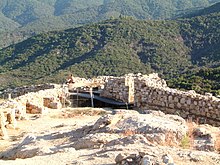Stagira (ancient city)
 Remains of the town wall of Stagira | |
| Alternative name | Stageira |
|---|---|
| Location | Olimpiada, Central Macedonia, Greece |
| Type | Settlement |
| History | |
| Builder | Ionian settlers from Andros |
| Founded | 655 BC |
| Associated with | Aristotle |
| Site notes | |
| Condition | Ruined |
| Ownership | Public |
| Management | 16th Ephorate of Prehistoric and Classical Antiquities |
| Public access | Yes |
| Website | Hellenic Ministry of Culture and Tourism |
Stagira (/stəˈdʒaɪrə/), Stagirus (/stəˈdʒaɪrəs/), or Stageira (Template:Lang-el or Στάγειρος) was an ancient Greek city, located in central Macedonia, near the eastern coast of the peninsula of Chalkidice, and is chiefly known for being the birthplace of Aristotle, who was a Greek philosopher and polymath, a student of Plato and teacher of Alexander the Great. The city lies approximately 8 kilometres north northeast of the present-day village of Stagira, close to the town of Olympiada.
Stagira was founded in 655 BC by Ionian settlers from Andros.[1] Xerxes I of Persia occupied it in 480 BC. The city later joined the Delian League, led by Athens, but left in 424 BC: as a result, the Athenian demagogue Cleon laid siege to it in 422 BC. However, Cleon was a poor strategist and his conduct of the siege was very inefficient: so much so that the ancient Greek comedy writer Aristophanes satirised him in the play The Knights.[2] Cleon died in the same year, in the battle of Amphipolis. Later, during the Peloponnesian War, Stagira sided with Sparta against the Athenians.[1]
In 348 BC, Philip II of Macedon occupied and destroyed the city.[1] In return for Aristotle's tutoring of his son Alexander, Philip later rebuilt the city and resettled the old city's inhabitants, who had been enslaved. Many new structures were built at this time, including an aqueduct, two shrines to Demeter and many houses.
References
External links
 Media related to Ancient Stageira at Wikimedia Commons
Media related to Ancient Stageira at Wikimedia Commons- Official website

